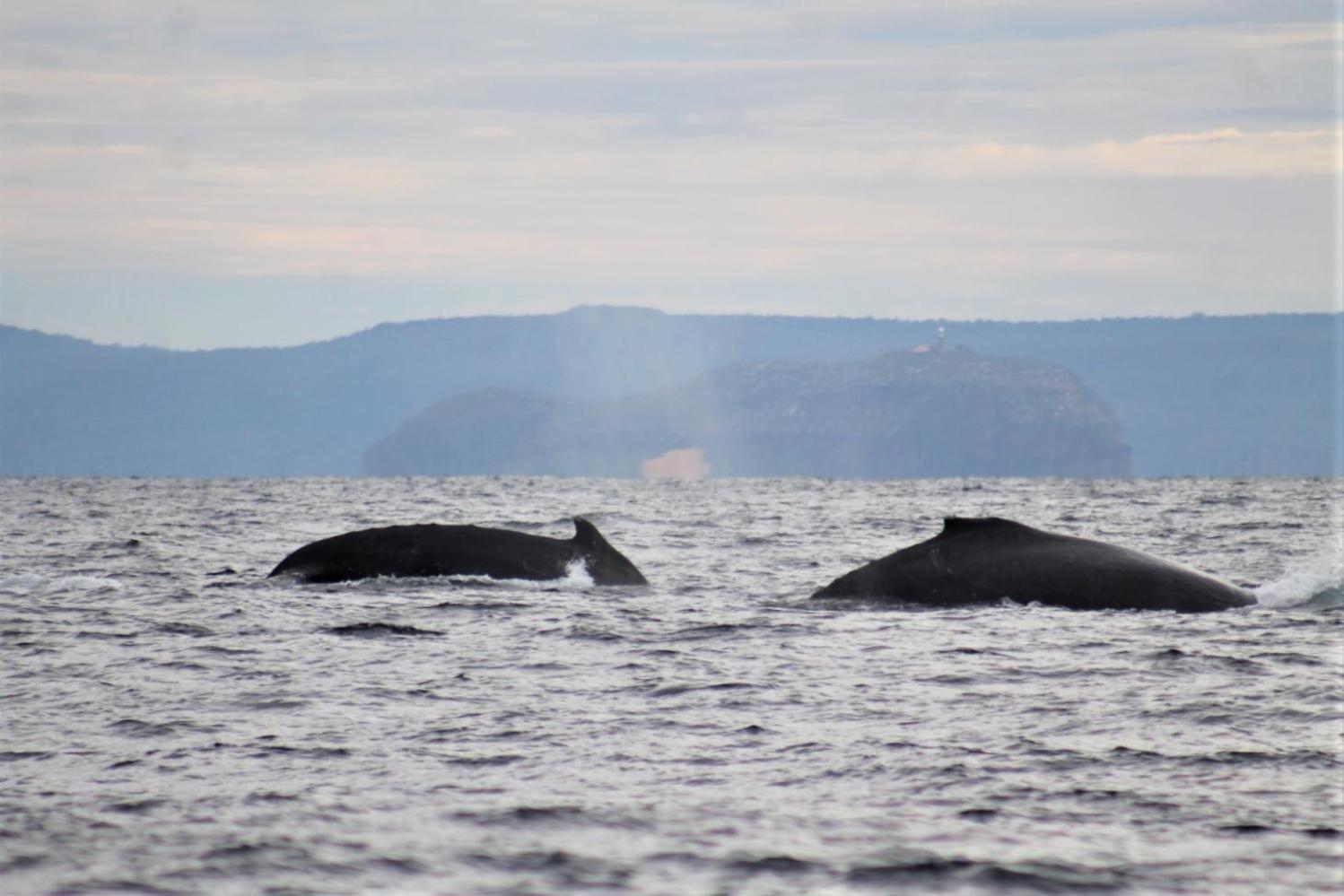Watching Whales Within Safe Limits: Please Give Them A Safe Passage By Sticking To The Rules for boats, drones, swimming
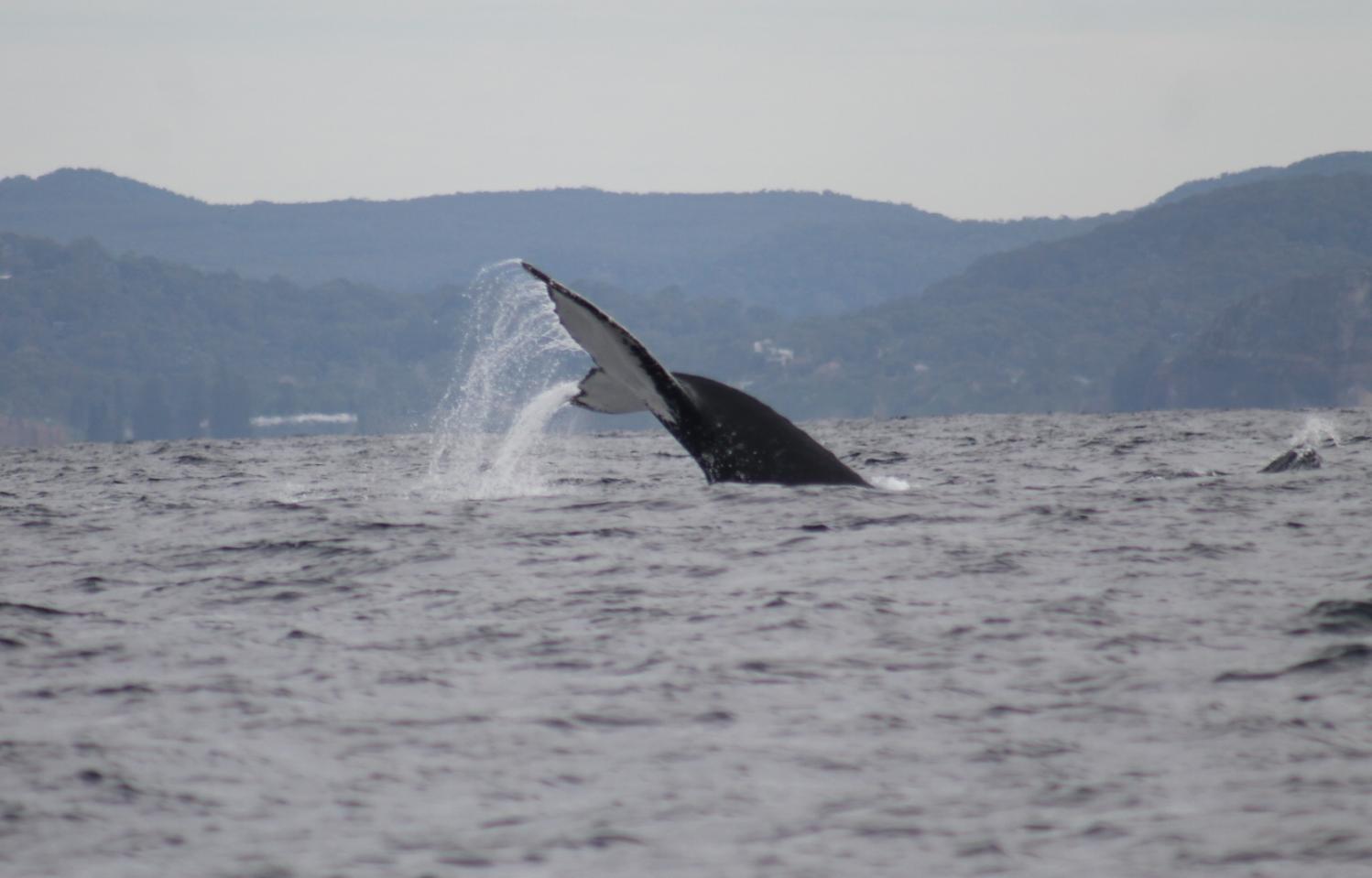
June 13, 2023
With the annual whale migration season in full swing along the south coast, the NSW National Parks and Wildlife Service is reminding all boaties and those on the water to respectfully watch these creatures from afar.
NPWS Area Manager Jo Issaverdis said this reminder comes after an incident where a small boat purposely approached a whale off Burrewarra Point, north of Broulee.
'While we are looking into this incident, our key message is one of education and awareness,' Ms Issaverdis said.
'We urge boaties, surfers, swimmers and everyone on the water to please give the whales space, and stay at least 100 meters away in all directions.
'This rule is in place to keep both the whales safe and the community safe.
'Adult humpbacks can weigh up to 35 tonnes and if frightened or threatened, can cause serious damage to vessels, passengers and swimmers.
'We understand why people want to get a closer look at these majestic creatures, but the reality is that interfering with the whale migration and getting too close is risky and unsafe for all.
'There are so many great vantage points from the coast where people can watch one of world’s great migrations, and with more than 35,000 humpbacks expected to pass the coast this season, you're guaranteed to see some,' Ms Issaverdis said.
Under the NSW Biodiversity Conservation Regulation 2017 all watercraft, including boats, surfboards, surf skis and kayaks must stay at least 100 m from a whale, and at least 300 m if a calf is present.
Restrictions also apply to swimmers, snorkellers, divers and those in the water, who must stay at least 30 m from a whale. There are also restrictions for aircraft, including drones.
From May to November each year, humpback whales make the annual migration from Antarctic waters to Queensland to calve, while southern right whales tend to stay in NSW’s protected bays and beaches to nurture their young.
Signs of disturbance
Disturbed whales, dolphins, dugongs and seals react with a sudden change of behaviour, including:
- hastily diving
- vocalising
- changes in breathing patterns
- sudden change in body posture or positioning
- a sudden change in direction
- a change in swimming speed
- aggressive behaviour such as tail splashing, head lunges and charging
- protectively moving between you and their young.
If you see someone intentionally harming, touching, harassing, chasing, trying to restrict the path of a marine mammal, or getting too close, please report the illegal activity to National Parks and Wildlife on 13000PARKS (1300 072 757).
Approach distance
An approach distance is the closest you can lawfully go to a whale, dolphin, dugong or seal to watch it safely and without disturbing or harassing them, so they can live naturally and without interference.
Scientists, including veterinarians, helped to develop the Biodiversity Conservation Regulation 2017, which outlines the approach distances for New South Wales. These are based on The Australian National Guidelines for Whale and Dolphin Watching 2017 and also includes seals.
Remember, if a marine mammal approaches you, slowly move back to at least the minimum approach distance. Never chase it; try to touch it or restrict its path. On a rare occasion, a National Parks and Wildlife Service officer may ask you to move back beyond the minimum approach distance if they see an animal is still distressed and behaving as if it is disturbed.
By observing the following approach distances, you can have a safe and enjoyable time while helping to keep our wildlife wild.
Whales, dolphins dugongs
The approach distance is determined by the activity you are doing, either in the air, or in or on water, the type of animal and if there is a calf present.
The exception is when a whale, dolphin or dugong that is mostly white in colour is present. You must always stay at least 500 metres from them.
Approaching when in the water – swimmers, snorkelers and divers
If you are a swimmer, snorkeler or diver, to observe a marine mammal, you may enter the water at a minimum distance of:
- 100 metres away from a whale
- 50 metres from a dolphin or dugong.
If you are in the water, you must keep at least:
- 30 metres from a whale, dolphin or dugong, including a calf.
For reference, 30 metres in length is approximately the same length as:
- an official basketball court
- 2 public transport buses lined up end to end.
Approaching on the water – boats and surfboards
A vessel is watercraft that can be used as transport, including motorised or non-motorised boats, surfboards, surf skis and kayaks.
If you are on the water in a vessel you are not permitted to approach a marine mammal from behind or wait in front of it.
If a calf is present, you are not permitted to enter the caution zone for closer viewing. The caution zone boundary is 300 metres for whales and 150 metres for dolphins and dugongs.
You must comply with the following approach rules:
A vessel is in the caution zone when it is:
- 300 metres from a whale
- 150 metres from a dolphin or dugong.
A vessel can move no closer than:
- 100 metres to a whale
- 50 metres to a dolphin or dugong.
In the caution zone the skipper must:
- post a lookout if 2 or more people are on board
- not position the vessel ahead of the animal to wait for it
- approach from the side at least 30 degrees to its direction of travel
- move at a constant slow speed with negligible wake – when the waves created by the movement of the prohibited vessel are so small that if there was a boat nearby it would not move
- only 3 vessels are permitted to be in the entire caution zone at any one time – other vessels must wait their turn, regardless of size and not drift closer.
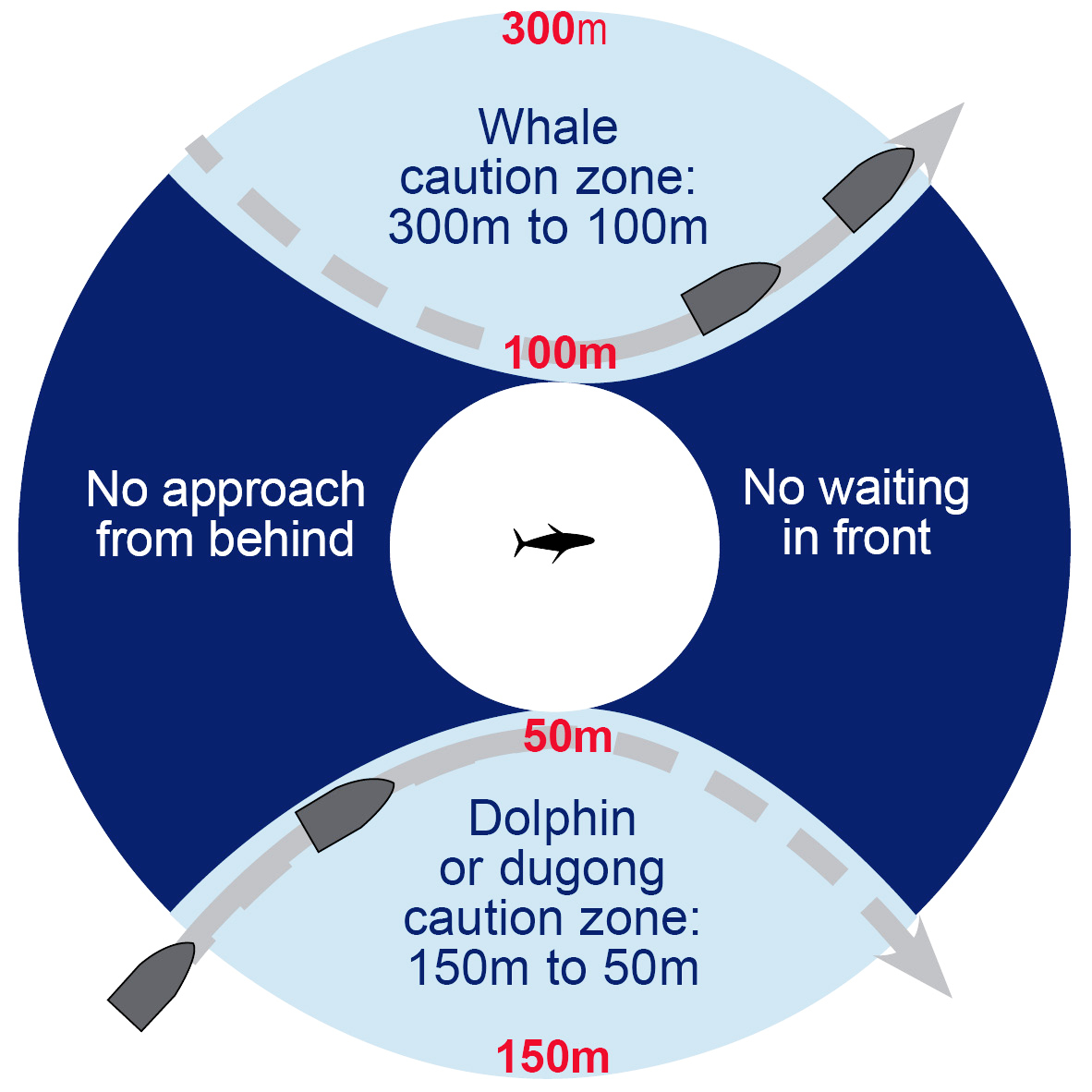
If dolphins are bow-riding, you must maintain course and speed.
If a whale approaches, slow down to minimal wash speed, move away or disengage gears and do not make sudden movements.
Approaching on the water – prohibited vessels
Prohibited vessels include personal motorised watercraft (jet skis), parasail boats, hovercraft, hydrofoils, wing-in-ground effect craft, remotely operated craft or motorised diving aids like underwater scooters.
These vessels are prohibited because they can make fast and erratic movements and not much noise underwater, so there is more chance they may collide with a marine mammal.
If you are approaching a marine mammal using a jet ski or other prohibited vessel you must have negligible wake and stay at least 300 metres from a whale, dolphin or dugong.
Approaching from the air – aircraft including drones
To observe a marine mammal from the air, you must approach it from behind, not hover over it and not land on the water to observe it. The pilot must also comply with Civil Aviation Safety Authority (CASA) requirements.
The approach distances for different types of aircraft are:
- 100 metres for drones (also known as RPAs and UAVs)
- 300 metres for fixed-wing aircraft
- 500 metres for helicopters and gyrocopters.
The approach distance for aircraft is the height above a marine mammal and the horizontal distance away from it.
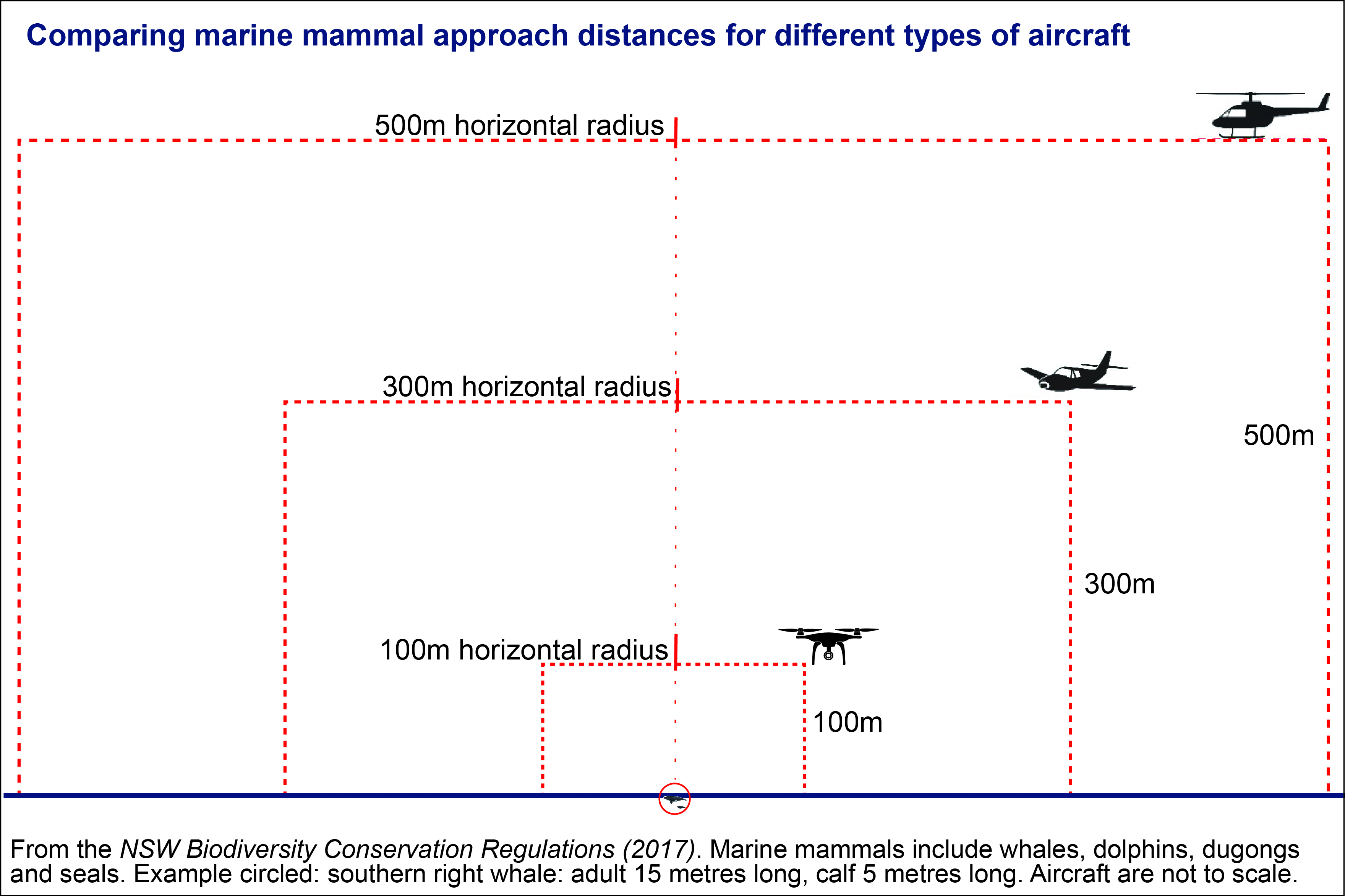
If you go closer than the approach distance, you have entered the no-fly zone. The no-fly zone for aircraft over a marine mammal can be imagined as an approach distance cylinder.
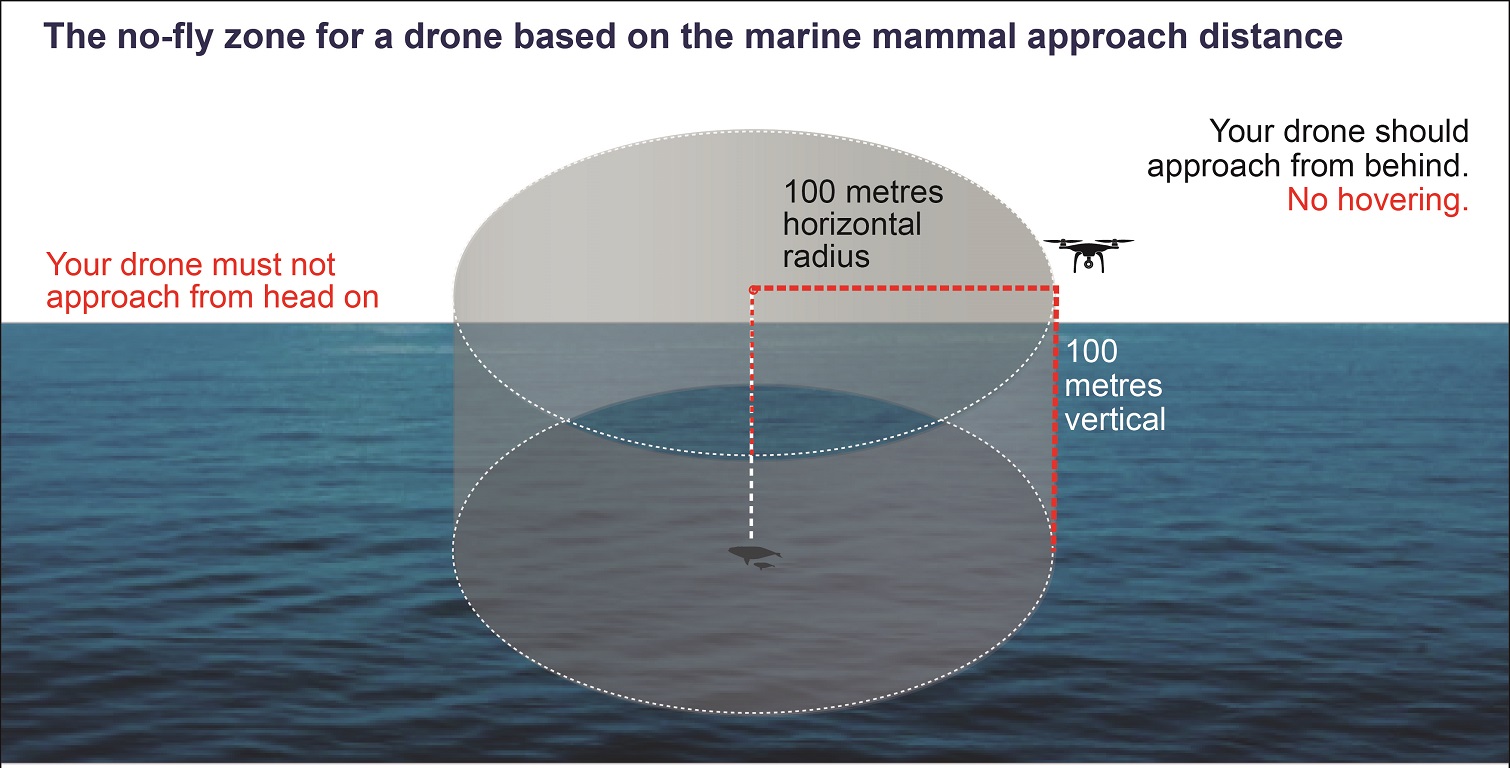
The 'no-fly zone' is shaped like a cylinder and moves with the whale, dolphin, dugong or seal. A drone can fly a minimum of 100 metres vertically over, and 100 metres horizontally around a marine mammal. A drone is not permitted to cut through the no-fly space. The aircraft is not to scale. Based on NSW Biodiversity Conservation Regulations (2017).
A drone pilot needs skill, understanding of the regulations and environmental awareness to lawfully approach a marine mammal. The drone pilot must always be in visual line of sight with the drone, not create any hazards and not cause harm to wildlife.
Listen for wildlife distress calls. If birds are disturbed, the pilot is advised to abandon the flight for 5 minutes, land and consider an alternate launch site or wait until birds of prey have left the area, or nesting birds have resettled, then try again.
Seek permission to launch from the landholder or land manager and follow all instructions. Do not launch from or fly over a national park without permission.
Seals
A seal may look like it is yawning but is actually baring its teeth as a warning sign.
Approach distances for seals are based on where the seal is located and if a pup is present. A seal is considered a pup if it is up to half the length of the adult.
If a seal comes towards you, you must move back to the minimum approach distance.
Approaching a seal when it is in the water
Seals are agile swimmers with strong flippers. When a seal is in the water you must keep at least:
- 10 metres away from the seal
- 80 metres from a seal pup
- 100 metres for a drone.
If you are also in or on the water and a seal approaches you, stay calm and move away slowly. If bitten or scratched, seek immediate medical advice.
Approaching a seal when it is hauled out on land
Seals haul out to rest after foraging at sea.
If a seal feels threatened, it may show aggression by yawning, waving its front flipper or head, or calling out. Seals are very agile and can move fast on land, using all 4 limbs to run. When a seal is hauled out on the land you must keep at least:
- 40 metres away from the seal
- 80 metres from a seal pup
- 100 metres away from the seal for a drone.
Seals can often have injuries that look quite alarming but will heal well without needing veterinary assistance.
If you are concerned call National Parks and Wildlife on 13000 PARKS (1300 072 757), or Organisation for the Rescue and Research of Cetaceans in Australia on 02 9415 3333 for the animal to be checked and monitored.
Vessels watching seals resting on the rocky shore must also keep back 40 metres or 80 metres if a pup is present. Limit the time you spend watching because it can be stressful for them. It is likely you are not the only vessel to approach them that day.
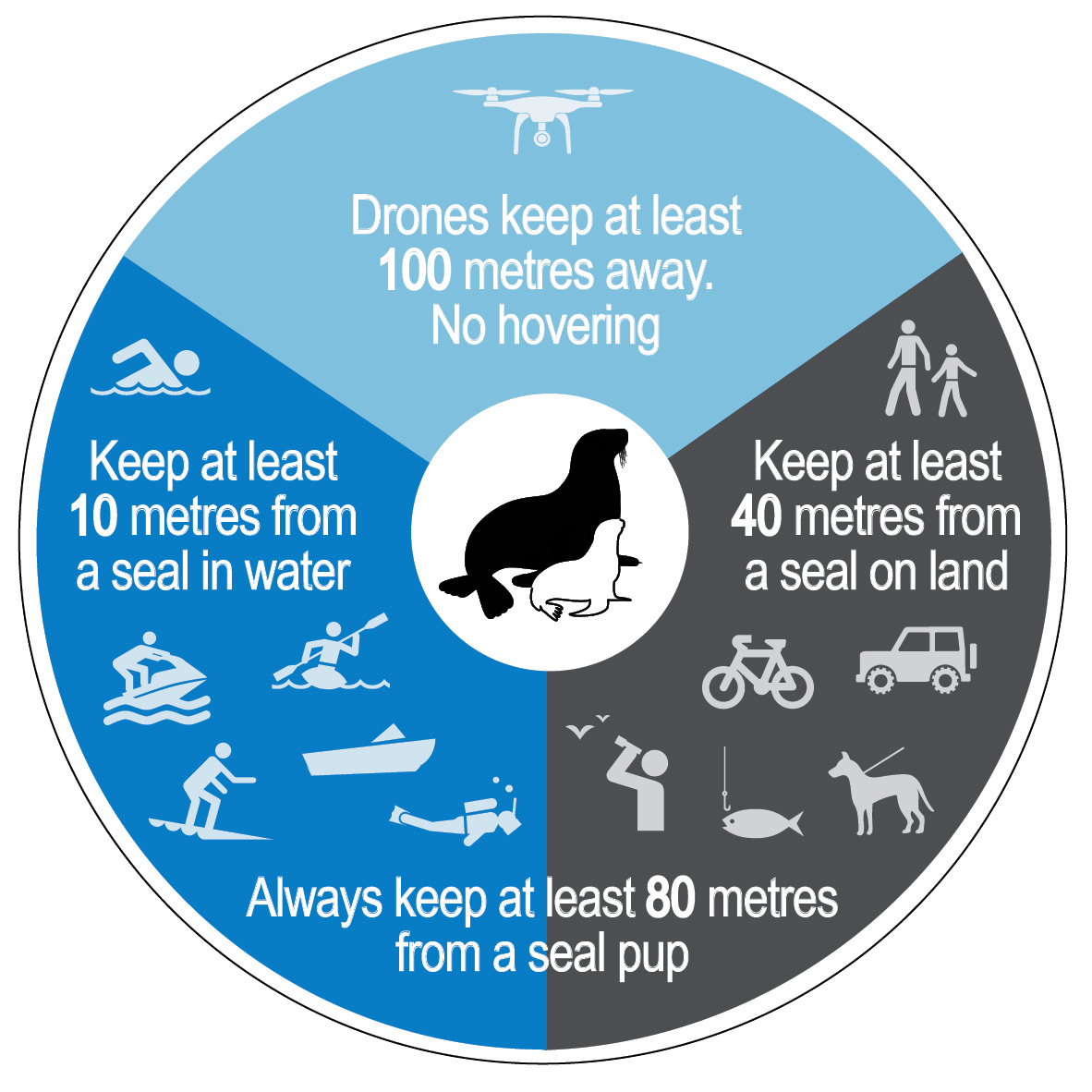
For more information on approach distances, please visit the NSW Environment website.
For information on whale watching vantage points along the South Coast’s National Parks and Reserves, visit the NPWS website.
Keep your dog restrained
With marine mammal populations slowly recovering in New South Wales, there is an increased chance that you will come across one when walking on a break wall or jetty. Keep your dog on a leash to avoid an unexpected encounter. This will reduce stress for the animal and reduce the chance of your dog being bitten. Dogs can transfer diseases to seals and vice versa.
A reminder that it is illegal to take dogs into National Parks.
Entangled whale, dolphin or seal
If you see an entangled animal:
- Watch from a distance, do not approach or enter the water or attempt to disentangle it.
- Immediately report it to:
- National Parks and Wildlife on 13000 PARKS (1300 072 757)
- Organisation for the Rescue and Research of Cetaceans in Australia on 02 9415 3333
Note the time, your location, the whale's direction of travel and speed.
Observe from a safe distance to:
- look for injuries and identifying marks
- take photographs of the entangling material to help rescuers bring the most suitable gear to remove it
- try to keep watch until help arrives.
Images/infographics: DPE/AJG-PON
